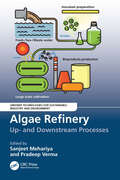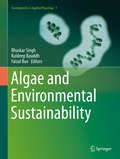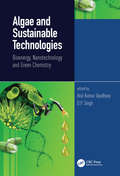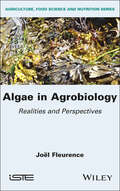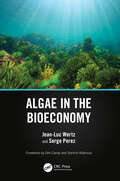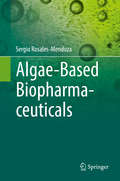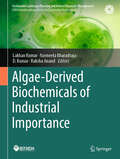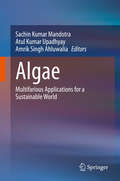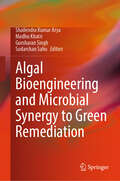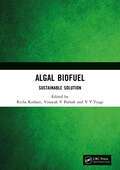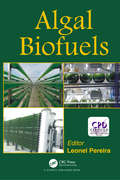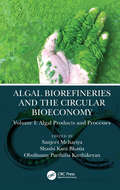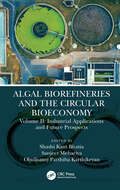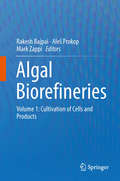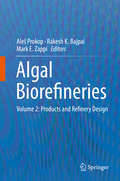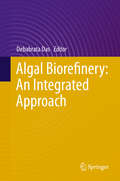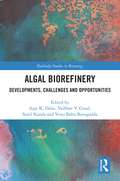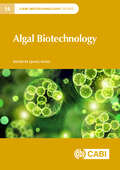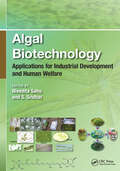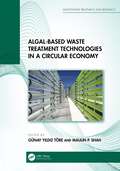- Table View
- List View
Algae Refinery: Up- and Downstream Processes (Greener Technologies For Sustainable Industry And Environment)
by Pradeep Verma Sanjeet MehariyaAlgae Refinery: Up- and Downstream Processes offers complete coverage of algae refinery, including up- and downstream processes while proposing an integrated algal refinery for the advancement of existing technologies and summarizing the strategies and future perspectives of algal refinery. It provides a concise introduction to the algal science, biology, technology, and application of algae. It explains downstream and upstream steps of algal refinery for the production of algal biomass, with several social benefits. Features: Provides various aspects of algal bioprocess including upstream and downstream processes Explains the major research streams of algae structures and their pathways Covers algal-based CO2 capture technology Explores the potential applications of algae for socioeconomical benefits Deliberates algal bioremediation approach for clean and sustainable development
Algae and Environmental Sustainability (Developments in Applied Phycology #7)
by Faizal Bux Bhaskar Singh Kuldeep BauddhThis book presents the dynamic role of algae in a sustainable environment. Two major aspects, namely bioenergy and bioremediation, have been elaborated in various chapter contributed by scientists and teachers from different geographical areas throughout the world. Algal biofuels is an emerging area of equal interest to researchers, industries, and policy makers working or focusing on alternative (i. e. renewable) fuels. Algae have been an area of interest due to their wide range of applications. Over the last 5 decades, eukaryotic algae have been used in the aquaculture industry as feed for invertebrates, providing a rich source of antioxidants, dietary fiber, minerals and protein. More recently, there has been a focus on the use of algal biomass in the development of alternative fuels. The extraction of oil from algae has been widely explored as a much more viable feedstock than plant-based oils in large-scale fuel production. using algae as feedstock has the advantages that it doesn't require arable land and that wastewater can be used as a source of nutrients in their culture. The multifunctional approach of algae includes pollution remediation, carbon sequestration, biofuels production, and delivery of value-added products. However, there are still some obstacles that need to be overcome to make their use as potential feedstock for biofuels techno-economically feasible. In order to maintain the sustainability aspect of algal biofuels, various aspects have to be studied and critically analyzed to assess the long-term sustainability of algal derived biofuels. This book discusses the role of algae as a promising future feedstock for biofuels. They are known to sequester carbon in much larger amounts than plants and as such the book also describes their phycoremediation potential for conventional as well as emerging contaminants. It describes the role of anaerobic digestion in algal biorefineries; bioreactions and process parameters; biogas recovery and reuse. The role of algal biofilm based technology in wastewater treatment and transforming waste into bio-products is discussed, and remediation of sewage water through algae is assessed. The book also describes the production of biohydrogen, bio-oil, biodiesel; and the major bottlenecks in their usage. The emerging characterization techniques of these biofuels (bio-oil and biodiesel) are described, as are the decolorizing potential of algae and the genetic engineering techniques that could enhance the production of lipids in algae. Other aspects of the book include the role of remote sensing technology in the monitoring of algae and a life cycle assessment of algal biofuels.
Algae and Sustainable Technologies: Bioenergy, Nanotechnology and Green Chemistry
by Atul Kumar Upadhyay D. P. SinghAlgal and sustainable technologies: Bioenergy, Nannotechnology and Green chemistry is an interdisciplinary overview of the world’s major problems; water scarcity, clean environment and energy and their sustenance remedy measures using microalgae. It comprehensively presents the way to tackle the socio-economic issues including food, feed, fuel, medicine and health and also entails the untapped potential of microalgae in environmental management, bioenergy solution and sustainable synthesis of pharmaceutical and nutraceutical products. This book basically emphasizes the success of algae as wonderful feed stocks of future and provides upto date information and sustainable and recreational outlook towards degrading environment and energy crisis. Applicability of fast emerging algae based nanotechnology in bioremediation and production of nanoparticle (AuNP, AgNP etc) are beautifully described along with latest research and findings. Key features: The "waste to best to income" strategies are the main concern of the book and take the edge off the problem of pollution, energy and income. Elucidate the sustainable phycoremediation and nanoparticle functions as low cost approach for various ecosystem services. Information regarding pharmaceuticals, nutraceuticals and other algae based value added product synthesis and fate are comprehensively discussed. Knowledge resource, latest research, findings and prospects presented in an accessible manner for researchers, students, eminent scientists, entrepreneurs, professionals and policy maker.
Algae as a Natural Solution for Challenges in Water-Food-Energy Nexus: Toward Carbon Neutrality (Environmental Science and Engineering)
by Abdelkader Anouzla Tonni Agustiono KurniawanThis book provides an overview of challenges and opportunities for algal management to mitigate climate change. This book offers new perspectives on how to control water pollution due to algae, while converting it to biosorbent and biodiesel that could be sold in market. The work also explores how to improve the performance of algae for such purposes. By identifying existing knowledge gap, this work uncovers new research directions for further development of algal management to address global environmental pollution. • Extensive literature survey (2001-2023) in algal management based on empirical approach in the body of knowledge • A comprehensive overview with critical analysis of algal management, for water treatment, biodiesel production, and food production, while dealing with climate change • Providing insights about challenges, research direction, outlook, and perspectives of algal management in Industry 4.0 era This book has an advantage that each chapter will be written by experts around the world working in their respective fields. As a result, this volume presents a balanced picture across the whole spectrum of algae. Furthermore, the authors are from both the developing and developed countries thus giving a worldwide perspective of looming climatic problems.
Algae for Biofuels and Energy (Developments in Applied Phycology #5)
by Navid R. Moheimani Michael A. BorowitzkaMicroalgae are one of the most studied potential sources of biofuels and bioenergy. This book covers the key steps in the production of renewable biofuels from microalgae - strain selection, culture systems, inorganic carbon utilisation, lipid metabolism and quality, hydrogen production, genetic engineering, biomass harvesting, extraction. Greenhouse gas and techno-economic modelling are reviewed as is the 100 year history of microalgae as sources of biofuels and of commercial-scale microalgae culture. A summary of relevant basic standard methods used in the study of microalgae culture is provided. The book is intended for the expert and those starting work in the field.
Algae for Food: Cultivation, Processing and Nutritional Benefits
by Shanmugam Hemaiswarya Rathinam Raja Kulanthaiyesu Arunkumar Isabel S. CarvalhoAlgae for Food: Cultivation, Processing and Nutritional Benefits Algae are a primitive, living photosynthetic form and they are the oldest living organism. In the marine ecosystem, algae are the primary producers that supply energy required to a diverse marine organism and especially seaweed provides a habitat for invertebrates and fishes. There have been significant advances in many areas of phycology. This book describes the advances related to food and nutrition of algae achieved during the last decades, it also identifies gaps in the present knowledge and needs for the future. The 17 chapters, grouped into 6 parts, are written by phycologists. More insight on industrial exploitation of algae and their products is supported by current studies and will help academia. The first part explains new technologies to improve the microalgal biomass, strain improvement and different methods of seaweed cultivation. In the second part, food and nutraceutical applications of algae, food safety aspects, green nanotechnology and formulation methods for the extraction and isolation of algal functional foods are described. The third part deals with pigments and carotenoids while the fourth part exploits the isolation and application of hydrocolloids, nutritional implications of algal polysaccharides and the characterization and bioactivity of fucoidans. In the fifth part, the biomedical potential of seaweed followed by agricultural applications of algae are well described. The book is an important resource for scholars that provides knowledge on wide range of topics. Key Features Covers important fields of algae from biomass production to genetic engineering aspects of algae Useful in the field of algal biotechnology, aquaculture, marine micro and macrobiology, microbial biotechnology and bioprocess technology Focuses on the therapeutic and nutritional areas of algae
Algae in Agrobiology: Realities and Perspectives
by Joel FleurenceAlgae, macroalgae and microalgae can be valuable biological resources in a new, more environmentally friendly form of agriculture known as agrobiology. Indeed, the biological properties associated with algae are frequently relevant for agricultural and zootechnical purposes. It is this aspect that is behind the current popularity of algae in the development of new agricultural practices that are related to plant and animal production, which are referred to as agrobiology. Algae in Agrobiology offers a current and forward-looking account of algae use: in agriculture and in the sector of land and marine animal production, as algal extracts and molecules in the form of fertilizers or biostimulants for crops with agronomic interest, and as algal compounds in the area of plant and animal health. This book is based on advances in biochemical and agronomic research in order to explain the conventional practices associated with the use of algae in agriculture and livestock breeding. These advances make it possible to establish possible uses for marine algal resources in the agriculture of the future.
Algae in Diabetes Management: Therapeutic Properties and Applications
by Shanmugam Hemaiswarya Rathinam Raja Muthusamy Sanjivkumar Tamil Selvan Silambarasan Grasian ImmanuelThis book describes the potential therapeutic benefits of algae in the management of diabetes. The work mainly focuses on the anti-diabetic properties of different types of algae, both marine and freshwater. The chapters present various bioactive compounds that exhibit anti-diabetic effects, finding their mechanisms of action and potential applications in diabetes management. These compounds may include polysaccharides, polyphenols, pigments etc. which have been identified for their ability to regulate glucose metabolism, improve the level of insulin sensitivity, and mitigate complications associated with the diabetes. The book aims to provide a foundation in the field of algae for diabetes. By consolidating the latest knowledge and highlighting the gaps in current understanding, it helps the fractionation of particular compounds, characterization, and clinical applications. Algae, with their rich biochemical resources and potential health benefits, represent an exciting avenue for exploration in the quest for novel anti-diabetic agents. The work contributes to the scientific analysis to explore the unexploited potential of algae in the area of diabetes management.
Algae in the Bioeconomy
by Jean-Luc Wertz Serge PerezAlgae play an important ecological role as oxygen producers and carbon sequesters and are the food base for all aquatic life. Algae are economically important as a source of crude oil, food and feed, and pharmaceutical and industrial products. High-value and sustainable products from algae are already economically viable and can be a fundamental driver for fuel production. Algae in the Bioeconomy provides a detailed overview of the chemical composition of algae and shows that an integrated biorefinery approach is necessary for large-scale algae production and conversion, where multiple products are produced. This book serves as a unique compendium of knowledge covering the essential features of algae and their applications. Discusses the structural chemistry and biology of micro- and macroalgal components Describes classification, occurrence, conversion, and production of micro- and macroalgae Offers strategies for optimal use of micro- and macroalgae in the bioeconomy, including regional strategies in the EU, US, China, India, Malaysia, Norway, and Chile Features forewords from international experts offering both a scientific and an economic/strategic viewpoint This book is intended for an interdisciplinary audience in chemical engineering, biotechnology, and environmental science and engineering, promoting research, development, and application of algae as a sustainable resource.
Algae-Based Biopharmaceuticals
by Sergio Rosales-MendozaThis book constitutes a key reference on the use of algae in the BFs production field; providing an updated outlook on the achievements accomplished thus far and transmitting a prospective view for this biotechnological application. This book provides a detailed description of the technology as well as an updated outlook of the strides achieved thus far in the field of algae-based biopharmaceuticals. Algae constitute attractive expression hosts for the production of recombinant proteins with medical applications. Among the features make them attractive candidates are: low cost, fast growth, wide biosynthetic capacity, and absence of human pathogens; which constitute substantial advantages with respect to bacterial and mammalian systems. First, the features of algae as convenient hosts for the production of BFs are analyzed in terms of production costs, biosynthetic capacity, and safety (Chapter 1). Second, the genetic engineering tools for algae-species are described. Nuclear and chloroplast-based expression approaches are analyzed and compared in terms of biosynthetic advantages, gene expression complexity, and DNA transfer approaches (Chapter 2). In the following sections, chapters 3 to 7, the state of the art on producing distinct types of BFs in algae species is presented. Although this book is mainly focused on BFs, considering that the production of compounds with health-promoting properties are achieved using genetically-engineered algae strains, chapter 8 deals with nutraceuticals. In the ninth chapter, the developments reported thus far are placed in perspective and challenges for the field are discussed. Critical future prospects comprise the following: optimizing large-scale production in bioreactors, implementing glycoengineering approaches, optimizing nuclear expression, exploring new approaches for oral delivery, and implementing regulatory frameworks to accomplish technology transfer and regulatory approval of algae-made BFs.
Algae-Derived Biochemicals of Industrial Importance (Sustainable Landscape Planning and Natural Resources Management)
by Navneeta Bharadvaja Lakhan Kumar Raksha Anand D. KumarThis book explores the applications of algal-derived biochemicals, which are now gaining attention for nutraceuticals, pharmaceuticals, cosmetics, bioplastics, biopolymers, bioglass, biofuels, and several other commercially valued compounds. This book will address the production of algal-based chemicals of industrial importance in terms of the recent advances, challenges, breakthroughs, and trends of applications for public health and environmental sustainability. The aim is to provide a comprehensive knowledge of several biochemicals, in particular, in terms of their category as—carotenoids, polyphenols, polysaccharides, fatty acids, biopolymers, and other secondary metabolites. It presents the techno-economic challenges, recent trends, and developments toward sustainable algal biochemical production with an emphasis on process development and product formulation. In addition, an in-depth analysis of market trends of algal biochemicals and algal bioeconomy has also been included. Facilitating the quantitative and qualitative analysis approaches for industrially important algae-to-biochemical production is the central idea of the book.
Algae: Anatomy, Biochemistry, and Biotechnology
by Laura Barsanti Paolo GualtieriA single-source reference on the biology of algae, the third edition of Algae: Anatomy, Biochemistry, and Biotechnology examines the most important taxa and structures for freshwater, marine, and terrestrial forms of algae. Its comprehensive coverage goes from algae's historical role through its taxonomy and ecology to its natural product possibilities. In this update, the authors have gathered a significant amount of new material, including: • more information on macroalgae • detailed description of biotic associations • updated description of biomass cultivation systems • coverage of different "omic" approaches and tools used in algal investigation • an expanded and updated algae utilization chapter The book's unifying theme is the important role of algae in the earth's self-regulating life support system and its function within restorative models of planetary health. It also discusses algae's biotechnological applications, including potential nutritional and pharmaceutical products. Written for students as well as researchers, teachers, and professionals in the field of phycology and applied phycology, this new full-color edition is both illuminating and inspiring.
Algae: Multifarious Applications for a Sustainable World
by Atul Kumar Upadhyay Sachin Kumar Mandotra Amrik Singh AhluwaliaThis exciting book presents diverse applications of microalgal renewable resources to meet modern demands for energy and value-added products. It also comprehensively describes the role of algae in sustainable and cost-effective wastewater treatment strategies, and highlights the latest research on, advances in and biotechnological relevance of algae in the areas of bioenergy, bioremediation, pharmaceuticals, nutraceuticals and green economy. The book addresses gaps in the fields of bioenergy, waste management, health and economy by providing broad information on bioenergy production, management strategies, drug development, nutraceuticals products and biobased economy using algae at the commercial level. The book introduces researchers to key and emerging innovations in the field of algal biology research and will assist policymakers, environmentalists, scientists, students and global thinkers in defining sustainable developmental goals for the future. Accordingly, it is an extremely important read for researchers and students in the environmental sciences, life sciences and chemistry, experts in the energy sector and policymakers alike.
Algal Bioengineering and Microbial Synergy to Green Remediation
by Shailendra Kumar Arya Madhu Khatri Gursharan Singh Sudarshan SahuThis comprehensive book delves into the synergy between algal bioengineering and microbial processes, revealing their potential to mitigate environmental impact and foster a sustainable future. Through a meticulous blend of theoretical insights and practical applications, this book provides readers with a holistic understanding of algal-microbial consortia. It scrutinizes the latest technological advancements in bioreactor design, offering real-world case studies that showcase successful implementations of these innovative solutions. Readers will gain valuable knowledge on the economic and regulatory landscapes shaping this field, equipping them to navigate and influence the industry effectively. Authored by leading experts, this book integrates perspectives from biology, engineering, and environmental science, making it an essential resource for researchers, industry professionals, and policymakers. It addresses critical challenges and presents actionable strategies for sustainable waste remediation, bridging the gap between theory and practice. Whether readers are an environmental scientist, biotechnologist, engineer, or sustainability manager, this book offers a treasure trove of insights and practical guidance. Discover how algal bioengineering and microbial synergy can revolutionize waste management and contribute to a greener, more sustainable future. Open the door to innovative solutions and join the movement towards an eco-friendly industrial paradigm with "Utilizing Algal Bioengineering and Microbial Synergy to Green Industry for Sustainable Waste Remediation".
Algal Biofuel: Sustainable Solution
by Richa Kothari V. V. Tyagi Vinayak V. PathakAlgal Biofuel: Sustainable Solution primarily focuses on the different aspects of bioenergy production using algal biomass as microalgae are considered the optimum feedstock for bioenergy production. The major aim is to thoroughly review the available bioenergy options, challenges in bioenergy production, availability of bioenergy feedstock, and biomass to bioenergy conversion process. This book also highlights the feasibility of lignocellulosic biomass, crop residues, and non-edible oil seeds for generation of different bioenergy products. It will be helpful for researchers and other stakeholders working in the area of bioenergy production for development of innovative concepts in emerging areas of bioenergy. Print edition not for sale in South Asia (India, Sri Lanka, Nepal, Bangladesh, Pakistan and Bhutan).
Algal Biofuels
by Leonel PereiraAlgae presents a viable biofuel alternative because the production of algae for fuel, unlike other agro-based biofuels, does not compete with food production. This book covers algae-based biofuel options and discusses the design and economic viability of algal bioenergy co-production concepts.
Algal Biorefineries and the Circular Bioeconomy: Algal Products and Processes
by Sanjeet Mehariya"Algae are mysterious and fascinating organisms that hold great potential for discovery and biotechnology." —Dr. Thierry Tonon, Department of Biology, University of York "Science is a beautiful gift to humanity; we should not distort it." —A.P.J. Abdul Kalam In this book, we emphasize the importance of algal biotechnology as a sustainable platform to replace the conventional fossil-based economy. With this focus, Volume 2 summarizes the up-to-date literature and knowledge and discusses the advances in algal cultivation, genetic improvement, wastewater treatment, resource recovery, commercial operation, and technoeconomic analysis of algal biotechnology. FEATURES Discusses in detail recent developments in algae cultivation and biomass harvesting Provides an overview of genetic engineering and algal-bacteria consortia to improve productivity Presents applications of algae in the area of wastewater treatment and resource recovery Provides case studies and technoeconomic analysis to understand the algal biorefinery Shashi Kant Bhatia, PhD, is an Associate Professor in the Department of Biological Engineering, Konkuk University, Seoul, South Korea. Sanjeet Mehariya, PhD, is a Postdoctoral Researcher at the Department of Chemistry, Umeå University, Umeå, Sweden. Obulisamy Parthiba Karthikeyan, PhD, is a Research Scientist and Lecturer (Adjunct) in the Department of Civil and Environmental Engineering, South Dakota School of Mines and Technology, Rapid City, South Dakota, USA.
Algal Biorefineries and the Circular Bioeconomy: Industrial Applications and Future Prospects
by Shashi Kant Bhatia"Algae are mysterious and fascinating organisms that hold great potential for discovery and biotechnology." —Dr. Thierry Tonon, Department of Biology, University of York "Science is a beautiful gift to humanity; we should not distort it." —A.P.J. Abdul Kalam In this book, we emphasise the importance of algal biotechnology as a sustainable platform to replace the conventional fossil-based economy. With this focus, Volume 2 summarizes up-to-date literature knowledge and discusses the advances in algal cultivation, genetic improvement, wastewater treatment, resource recovery, commercial operation, and technoeconomic analysis of algal biotechnology. FEATURES Discusses in detail recent developments in algae cultivation and biomass harvesting Provides an overview of genetic engineering and algal-bacteria consortia to improve productivity Presents applications of algae in the area of wastewater treatment and resource recovery Provides case studies and technoeconomic analysis to understand the algal biorefinery Shashi Kant Bhatia, PhD, is an Associate Professor in the Department of Biological Engineering, Konkuk University, Seoul, South Korea. Sanjeet Mehariya, PhD, is a Postdoctoral Researcher in the Department of Chemistry, Umeå University, Umeå, Sweden. Obulisamy Parthiba Karthikeyan, PhD, is a Research Scientist and Lecturer (Adjunct) in the Department of Civil and Environmental Engineering, South Dakota School of Mines and Technology, Rapid City, South Dakota, USA.
Algal Biorefineries: Volume 1: Cultivation of Cells and Products
by Aleš Prokop Rakesh Bajpai Mark ZappiThis book reviews efforts to produce chemicals and fuels from forest and plant products, agricultural residues and more. Algae can potentially capture solar energy and atmospheric CO2; the book details needed research and legislative initiatives.
Algal Biorefineries: Volume 2: Products and Refinery Design
by Aleš Prokop Rakesh K. Bajpai Mark E. ZappiAlgae offer potential to produce renewable chemicals and fuels using solar energy and carbon dioxide from atmosphere or in flue gases while simultaneously reducing the generation of greenhouse gases. Since these can be grown on marginal lands with micronutrients and macronutrients often present in waste streams, algae-based chemicals and fuels do not compete with foods. Still large-scale production of algae-based fuels and chemicals faces considerable technological and economical challenges and it would by necessity require a biorefinery approach wherein all the possible algal components are converted into value-added compounds. The present series on algal biorefineries represents a forum for reporting the state of the art of different technologies as well as the latest advances in this field. The volume II of this series complements the volume I in terms of the current state of the art. Different chapters in this volume address diverse issues ranging from genetically modifies algae to new products to life-cycle analysis of algal products.
Algal Biorefinery: An Integrated Approach
by Debabrata DasThis book critically discusses different aspects of algal production systems and several of the drawbacks related to microalgal biomass production, namely, low biomass yield, and energy-consuming harvesting, dewatering, drying and extraction processes. These provide a background to the state-of-the-art technologies for algal cultivation, CO2 sequestration, and large-scale application of these systems. In order to tap the commercial potential of algae, a biorefinery concept has been proposed that could help to extract maximum benefits from algal biomass. This refinery concept promotes the harvesting of multiple products from the feedstock so as to make the process economically attractive. For the last few decades, algal biomass has been explored for use in various products such as fuel, agricultural crops, pigments and pharmaceuticals, as well as in bioremediation. To meet the huge demand, there has been a focus on large-scale production of algal biomass in closed or open photobioreactors. Different nutritional conditions for algal growth have been explored, such as photoautotrophic, heterotrophic, mixotrophic and oleaginous. This book is aimed at a wide audience, including undergraduates, postgraduates, academics, energy researchers, scientists in industry, energy specialists, policy makers and others who wish to understand algal biorefineries and also keep abreast of the latest developments.
Algal Biorefinery: Developments, Challenges and Opportunities (Routledge Studies in Bioenergy)
by Sonil Nanda Ajay K. Dalai Vaibhav V. Goud Venu Babu BorugaddaThis book enables readers to understand the theoretical aspects, key steps and scientific techniques with a detailed mechanism to produce biofuels from algae. Each chapter provides the latest developments and recent advancements starting from algal cultivation techniques to the production of value-added green fuels, chemicals and products with wide applications. The volume brings together a broad range of international and interdisciplinary experts, including chemical and biological engineers, biotechnologists, process engineers, environmentalists, pharmacists and nutritionists, to one platform to explore the beneficial aspects and challenges for an algal-based biorefinery. Chapters address cutting-edge issues surrounding algal cultivation, including genetic modification of algal strains, design and optimization of photobioreactors and open-pond systems, algal oil extraction techniques and algal-derived fuel products (biodiesel, bio-gasoline, jet fuels and bio-oil). Finally, the book considers the potential environmental impacts for establishing a sustainable algal biorefinery through lifecycle analysis, techno-economic assessment and supply chain management. This book will be an important resource for students, academics and professionals interested in algal cultivation, biofuels and agricultural engineering, and renewable energy and sustainable development more broadly.
Algal Biotechnology (CABI Biotechnology Series)
by Sanjay Gupta Jin Wang Vinod Kumar Xu Zhang Lei Chen Chao Li Weiwen Zhang Xinyu Song Xiaojun Yan Chengxu Zhou Roger Ruan Yahui Bo Gao Chen Zhenfan Chen Zixi Chen Pengfei Cheng Feng Ge Jiameng Guo Xiahui Hao Qingfang He Fan Hu Hanhua Hu Krishna Kumar Jaiswal Hu Jin Anping Lei Anna I. Kurbatova Yanhua Li Hanzhi Lin Lu-Ning Liu Qiong Liu Yandu Lu Anastasios Melis Yufang Pan Vishal Rajput Shengzhou Shan Kaitlin Simmons Xiaotong Song Adamu Yunusa Ugya Mikhail S. Vlaskin Chun Wang Jiangxin Wang Wenxiu Yin Xiangxiang Zhang Yu-Zhong Zhang Long-Sheng Zhao Quanyu Zhao Yali Zhu Zhu Zhen Tian Jing Cao XupengAlgae are sunlight-driven cell factories, and can efficiently absorb CO2 and convert light energy to chemical energy such as lipid, starch and other carbohydrates and release O2. Algal feedstock is a promising resource for bioproduct production, given its high photosynthetic efficiency for producing biomass compared to conventional crops. Microalgae can be used for flue-gas and wastewater bioremediation. This book highlights recent breakthroughs in the multidisciplinary areas of algal biotechnology and the chapters feature recent developments from cyanobacteria to eukaryotic algae, from theoretical biology to applied biology. It also includes the latest advancements in algal-based synthetic biology, including metabolic engineering, artificial biological system construction and green chemicals production. With contributions by leading authorities in algal biotechnology research, it is a valuable resource for graduate students and researchers in the field, and those involved in the study of photosynthesis and green-cell factories.
Algal Biotechnology: Applications for Industrial Development and Human Welfare
by S. Sridhar Nivedita SahuThis book deals with an interdisciplinary approach towards present-day practical challenges and recent developments in algal biotechnology and covers a broad spectrum of issues ranging from diverse algae and its applications in agriculture, human food, animal feed, wastewater treatment, and industry to algal metabolites. Major themes covered in this volume include algae-based processes for the treatment of industrial effluents, algal biorefinery, industrial trends, and applications of algae in food, feed, nutraceuticals, and pharmaceuticals.Features: Explores the possibility of utilization of algae in human food and pharmaceutical compounds. Presents recent state of the art of design and tools in algal biorefineries. Reviews concepts of membrane bioreactors and microbial fuel cells, including their process and performance. Algae-based technologies for safe and eco-friendly processes to promote a sustainable bio-economy. Discusses algae as a source for potential aquafeed. This book is aimed at graduate students and researchers in biotechnology, bioenergy , renewable energy, energy, fuel and petrochemicals, wastewater, novel technologies, clean technologies, bioremediation environmental biotechnology, functional foods and nutraceuticals, and marine and aquatic science.
Algal-based Waste Treatment Technologies in a Circular Economy (Wastewater Treatment and Research)
by Maulin P. Shah Günay Yıldız TöreIn recent years, problems such as environmental pollution, global warming, and high energy consumption have brought waste treatment technologies to the forefront. As the scientific world turns to sustainable, environmentally friendly, and ecologically sound energy sources, microalgae-based technologies have become one of the most intensely studied subjects in academia. This book delves deeper into the emergence of microalgae as the green alternative that could lead the world toward adopting a circular economy and zero-discharge approach.With insights from professors and industry experts in the field, this book provides new perspectives on the day-to-day environmental applications of microalgal technologies in waste treatment and management as well as recycling. It also explores the environmental impact of traditional waste treatment and recovery technologies and highlights how algae-based technologies can serve as an eco-friendly alternative in microplastic removal and biofuel production. This book equips readers with the essential knowledge on algae-based phycoremediation technologies, with special emphasis on their use in conventional treatment facilities to remove harmful contaminants and stabilize pH for effective bacterial treatment.This is a valuable resource for environmentalists, scientists, and technologists around the world. It will also be of interest to academics and students within the disciplines of Phycology, Water Systems Engineering, Environmental Science and Remediation, and Sustainable Development.
